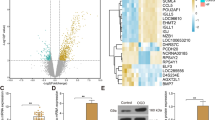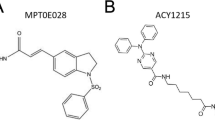Summary
Heart failure (HF) is the end stage of various kinds of cardiovascular diseases and leads to a high mortality worldwide. Numerous studies have demonstrated that frequencies of CD4+CD25+Foxp3+ regulatory T cells (Tregs) are reduced in HF patients and properly expanding Tregs attenuates HF progression. Histone deacetylase (HDAC) 9 has been revealed to contribute to several cardiovascular and cerebrovascular diseases. Plenty of studies showed that HDAC9 negatively regulated the number and function of Tregs. Thus, we aim to investigate the expression of HDAC 9 in patients with chronic heart failure (CHF) and the relationship among HDAC9, Tregs and CHF. Our research showed a reduced number of Tregs and an increased expression of HDAC9 mRNA in CHF patients. Patients with CHF were divided into two groups by heart function grade of New York Heart Association (NYHA), we found that the HDAC9 mRNA expression level in NYHA grade II–III group were lower than that in NYHA grade IV group. More importantly, the correlation study suggested that the expression of HDAC9 mRNA was negatively correlated to Tregs frequency and left ventricular ejection fraction (LVEF), whereas positively correlated to larger left ventricular end-diastolic dimension (LVEDD) and B-type natriuretic peptide (BNP) in patients with CHF. The correlation studies also showed a positive correlation between HDAC9 and the severity of CHF. Our research suggests that HDAC9 may be a new indicator for assessing CHF and it may offer a new direction for research of CHF.
Similar content being viewed by others
References
Heeschen C, Hamm CW, Mitrovic V, et al. N-terminal pro-B-type natriuretic peptide levels for dynamic risk stratification of patients with acute coronary syndromes. Circulation, 2004,110(20):3206–3212.
Ho KK, Anderson KM, Kannel WB, et al. Survival after the onset of congestive heart failure in Framingham Heart Study subject. Circulation, 1993,88(1):107–115.
Fonarow GC, Peacock WF, Phillips CO, et al. Admission B-type natriuretic peptide levels and in-hospital mortality in acute decompensated heart failure. J Am Coll Cardiol, 2007,49(19):1943–1950
Tang TT, Ding YJ, Liao YH, et al. Defective circulating CD4+CD25+Foxp3+CD127low regulatory T-cells in patients with chronic heart failure. Cell Physiol Biochem, 2010,25(4-5):451–458
Okamoto N, Noma T, Ishihara Y, et al. Prognostic value of circulating regulatory T cells for worsening heart failure in heart failure patients with reduced ejection fraction. Int Heart J, 2014,55(3):271–277
Kvakan H, Kleinewietfeld M, Qadri F, et al. Regulatory T cells ameliorate angiotensin II-induced cardiac damage. Circulation, 2009,119(22):2904–2912
Matsumoto K, Ogawa M, Suzuki J, et al. Regulatory T lymphocytes attenuate myocardial infarctioninduced ventricular remodeling in mice. Int Heart J, 2011,52(6):382–387
Wang H, Hou L, Kwak D, et al. Increasing Regulatory T Cells With Interleukin-2 and Interleukin-2 Antibody Complexes Attenuates Lung Inflammation and Heart Failure Progression. Hypertension, 2016,68(1):114–122
Beier UH, Wang L, Han R, et al. Histone Deacetylases 6 and 9 and Sirtuin-1 Control Foxp3+ Regulatory T Cell Function Through Shared and Isoform-Specific Mechanisms. Sci Signal, 2012,5(229): ra45
Zhang HT, Xiao Y, Zhu ZQ, et al. Immune regulation by histone deacetylases: a focus on the alteration of FOXP3 activity. Immunol Cell Biol, 2012,90(1):95–100
de Zoeten EF, Wang LQ, Sai H, et al. Inhibition of HDAC9 Increases T Regulatory Cell Function and Prevents Colitis in Mice. Gastroenterology, 2010,138(2):583–594
Qingxu G, Yan Z, Jiannan X, et al. Association Between the Gene Polymorphisms of HDAC9 and the Risk of Atherosclerosis and Ischemic Stroke. Pathol Oncol Res, 2016,22(1):103–107
Cao Q, Rong S, Repa JJ, et al. Histone deacetylase 9 represses cholesterol efflux and alternatively activated macrophages in atherosclerosis development. Arterioscler Thromb Vasc Biol, 2014,34(9):1871–1879
Zhang CL, McKinsey TA, Chang S, et al. Class II histone deacetylases act as signal-responsive repressors of cardiac hypertrophy. Cell, 2002,110(4):479–488
Choi SW, Gatza E, Hou G, et al. Histone deacetylase inhibition regulates inflammation and enhances Tregs after allogeneic hematopoietic cell transplantation in humans. Blood, 2015,125(5):815–819
International Stroke Genetics Consortium, Wellcome Trust Case Control Consortium 2, Bellenguez C, et al. Genome-wide association study identifies a variant in HDAC9 associated with large vessel ischemic stroke. Nat Genet, 2012,44(3):328-333
Markus HS, Makela KM, Bevan S, et al. Evidence HDAC9 genetic variant associated with ischemic stroke increases risk via promoting carotid atherosclerosis. Stroke, 2013,44(5):1220–1225
Chang S, McKinsey TA, Zhang CL, et al. Histone deacetylases 5 and 9 govern responsiveness of the heart to a subset of stress signals and play redundant roles in heart development. Mol Cell Biol, 2004,24(19):8467–8476
Author information
Authors and Affiliations
Corresponding author
Rights and permissions
About this article
Cite this article
Liao, Pp., Liu, Lh., Wang, B. et al. Correlation between Histone Deacetylase 9 and Regulatory T Cell in Patients with Chronic Heart Failure. CURR MED SCI 38, 199–203 (2018). https://doi.org/10.1007/s11596-018-1866-5
Received:
Revised:
Published:
Issue Date:
DOI: https://doi.org/10.1007/s11596-018-1866-5




